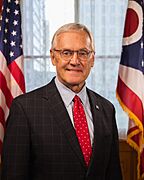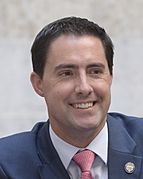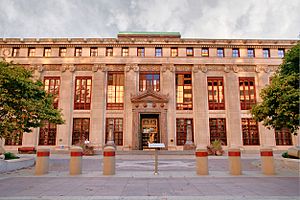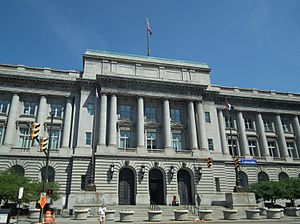Government of Ohio facts for kids

|
|
| Polity type | Presidential republic Federated state |
|---|---|
| Constitution | Constitution of Ohio |
| Legislative branch | |
| Name | General Assembly |
| Type | Bicameral |
| Meeting place | Ohio Statehouse |
| Upper house | |
| Name | Senate |
| Presiding officer | Rob McColley, President |
| Lower house | |
| Name | House of Representatives |
| Presiding officer | Matt Huffman, Speaker |
| Executive branch | |
| Head of State and Government | |
| Title | Governor |
| Currently | Mike DeWine |
| Appointer | Election |
| Cabinet | |
| Name | Cabinet |
| Leader | Governor |
| Deputy leader | Lieutenant Governor |
| Headquarters | Ohio Statehouse |
| Judicial branch | |
| Name | Judiciary of Ohio |
| Courts | Courts of Ohio |
| Supreme Court | |
| Chief judge | Sharon Kennedy |
| Seat | Thomas J. Moyer Ohio Judicial Center, Columbus |
The government of the U.S. state of Ohio is how the state is run. It has three main parts: the executive, judicial, and legislative branches. These parts work together to make sure Ohio's laws are followed and that the state runs smoothly. The basic rules for Ohio's government are found in the Ohio Constitution and the law of Ohio.
Contents
Executive Branch: Leading the State
The executive branch is in charge of carrying out the state's laws every day. Six officials are elected by people across the state to help lead Ohio. These officials include the Governor, who is the chief leader, and the Lieutenant Governor, who is second in command. Other important elected officials are the Secretary of State, the Attorney General, the State Treasurer, and the State Auditor. Many state agencies and their employees also help the executive branch do its work.
- Statewide Elected Executive Officials
-
Mike DeWine (R)
Governor
All these officials are elected for four-year terms. They run for office as members of political parties. The Governor and Lieutenant Governor are elected together on one ballot.
State Departments: How Ohio Works Daily
The state government is organized into many departments. These departments help manage different areas of public service.
- Department of Administrative Services
- Department of Aging
- Department of Agriculture
- Office of Budget and Management
 The Rhodes State Office Tower in Columbus
The Rhodes State Office Tower in Columbus - Department of Commerce
- Department of Development
- Department of Developmental Disabilities
- Department of Education
- Environmental Protection Agency
- Department of Health
- Department of Insurance
- Department of Job and Family Services
- Department of Medicaid
- Department of Mental Health and Addiction Services
- Department of Natural Resources
- Department of Public Safety
- Department of Rehabilitation and Correction
- Department of Taxation
- Department of Transportation
- Department of Veterans Services
- Department of Youth Services
New rules and notices from these departments are published in the Register of Ohio. These rules then become part of the Ohio Administrative Code.
Legislative Branch: Making Laws
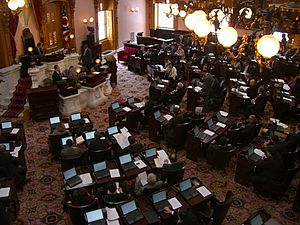
The legislative branch is called the Ohio General Assembly. Its main job is to create laws for Ohio. It has two parts: the Senate and the House of Representatives.
The House of Representatives has 99 members. Each member represents a specific area of Ohio with about the same number of people. The Senate has 33 members. Each Senate district is made up of three House districts. Senators serve four-year terms, while representatives serve two-year terms.
The General Assembly also helps decide the boundaries for Ohio's 15 seats in the United States House of Representatives. The Ohio Apportionment Board draws the lines for the state legislative districts.
For a bill to become a law, both the Senate and the House of Representatives must approve it. Then, the Governor must sign it. If the Governor does not agree with a bill, they can veto it. However, the General Assembly can still make the bill a law if three-fifths of members in both houses vote to override the veto. A bill can also become a law if the Governor does not sign or veto it within 10 days. The official state laws are published in the Laws of Ohio and are organized in the Ohio Revised Code.
Judicial Branch: Interpreting Laws
The judicial branch is responsible for interpreting Ohio's laws and making sure they are applied fairly. The highest court in Ohio is the Ohio Supreme Court. It has one chief justice and six other justices. All justices are elected for six-year terms.
Ohio's court system has several levels of elected judges:
- State Court of Claims: This court handles lawsuits against the State of Ohio.
- State Courts of Appeal: There are 12 district appeals courts. These courts review decisions made by lower courts.
- County Courts of Common Pleas: There are 88 of these courts, one for each county. They are the main courts for civil (non-criminal) and criminal cases. In busy areas, these courts might have special divisions for things like juvenile cases or family matters.
- Municipal Courts and County Courts: These courts handle smaller issues. This includes traffic tickets, minor crimes, and small claims.
Most judges in Ohio are elected by the people. However, judges for the Court of Claims are assigned by the chief justice. If an elected judge position becomes temporarily empty, the chief justice also assigns someone to fill that spot.
Local Government: Serving Communities
Besides the state government, Ohio also has several levels of local government. These include counties, municipalities (which are cities and villages), townships, and school districts.
Ohio is divided into 88 counties. Most counties follow a standard government structure. This includes a three-member board of county commissioners and other elected officials like a sheriff and treasurer. Some counties, like Summit County and Cuyahoga County, have chosen a different way to govern themselves.
There are two types of municipalities: cities and villages. A community becomes a city if it has 5,000 or more residents, based on the latest United States Census. If it has fewer than 5,000 residents, it is a village. Municipalities have the power to create their own laws and rules. Most have elected mayors and city councils. City governments usually provide more services than county governments, such as police and fire departments.
The entire area of Ohio is also covered by townships. Townships are governed by a three-member board of trustees. If a city or village grows to cover an entire township, that township government might stop existing separately.
Ohio has over 600 school districts that provide K-12 education. There are also vocational school districts for job training. Each school district is managed by an elected board of education.
See also
- Politics of Ohio
- Law of Ohio



